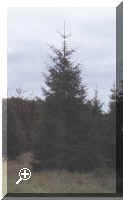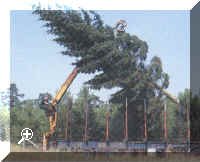The Elveden Woods Department.
Since the beginning of time woods and forests have been used by local
populations for many different purposes. In the 19th and early 20th century as
shooting developed on the Estate so did the tree planting; as well as creating
privacy around Elveden Hall the main purpose was to stabilise the Breckland
sands and to create nesting habitats for the game-birds. During the 1920's,
agricultural development began in earnest and the emphasis for tree planting
changed slightly with Scots Pine being used to create field boundaries and to
stabilise the arid sands in order to establish arable land on which to grow
crops. The structure of forestry seen today on the Estate is for the most part
less than 100 years old and almost exclusively has it's origins in either
shooting and/or field establishment.
Elveden became a major producer of milk which culminated by the 1960's in
nine dairy herds with over 1200 milch cows. This amount of livestock required an
enormous amount of stock fencing and many of the belts planted originally for
game cover were now being enlarged with a view to producing fencing materials
for the future. In 1980 the decision was made to stop dairy production and to
increase the amount of arable land which would be used for growing vast acreages
of vegetables and cereals, which still continues to this day. This obviously
meant that the Estate's requirements for stock fencing came to an end and the
main objective for the forestry compartments changed once again to that of
producing timber.
Today the Scots Pine has become recognised as part of the Breckland landscape
and in particular the single and double rows which were planted in the early
part of the century. Broad-leaved trees were used in the landscaped areas around
Elveden Hall and today, beech, oak, sweet chestnut, horse chestnut and hornbeam
are amongst some of the oldest trees in the Park.
Adding to the landscape are species such as wellingtonia, cedar and grand
fir. Forestry today continues to serve all the objectives that it has in the
past, namely, pheasant coverts, creating field boundaries, stabilising sand blow
and of course, timber production.
Elveden Christmas Trees.
The multi-functional purposes of the woodland com partments
at Elveden required that income be generated from forestry products other than
for pure timber.. During the mid 1970's a small Christmas Tree outlet was
developed in Elveden village. This small enterprise began to grow to the point
where in 1991over 40,000 trees were being sold annually into the wholesale
trade, together with about 1,000 trees retailed at Elveden.
partments
at Elveden required that income be generated from forestry products other than
for pure timber.. During the mid 1970's a small Christmas Tree outlet was
developed in Elveden village. This small enterprise began to grow to the point
where in 1991over 40,000 trees were being sold annually into the wholesale
trade, together with about 1,000 trees retailed at Elveden.
The two primary species grown are Norway Spruce and Scots Pine. Over the
years problems have arisen with growing Norway Spruce in Breckland due to the
low rainfall and the high risk of frost damage in the early part of the growing
season. To mitigate these hazards developments have been made in growing
techniques and tree marketing has also changed. Elveden now runs three retail
outlets for the domestic size Christmas Tree and also supplies  display
trees, up to 20 metres tall, for town and city centres nation-wide. Many notable
venues have an Elveden Christmas Tree as their centre-piece, including
Sandringham House, St. Paul's Cathedral and more locally, Ely Cathedral.
display
trees, up to 20 metres tall, for town and city centres nation-wide. Many notable
venues have an Elveden Christmas Tree as their centre-piece, including
Sandringham House, St. Paul's Cathedral and more locally, Ely Cathedral.
Elveden Deer Management.
Elveden hosts four species of deer:- Red, Fallow, Roe and Muntjac. All
species are wild and there are no penned or Park deer on the Estate.
Red Deer
The Red Deer in Breckland are reputed to be the largest land mammals in the
UK with mature stags weighing up to 600 lbs live weight. The Breckland herd is
estimated at 700 animals, and the part of that herd resident in Elveden averages
100. The Red Deer impact heavily on the Estate and cause damage to both
forestry, arable and environmental crops. Due to the transient and herding
nature of these deer, a deer management group has been in existence for over 25
years; with the principal objective of co-ordinating cull targets between the
numerous land-owners in the area.
Fallow Deer
The Fallow Deer population on the estate is small and originates from escaped
park deer in the locality. Our estimate of this population is less than 50
animals, and although monitoring and culling takes place, fallow deer are not
considered major damaging pests, nor do they figure highly on our cull
policy.
Roe Deer
Roe Deer are the most numerous on the Estate with an estimated population of
between 500 and 600. The quality of deer is poor due to an introduction made in
1840 from Germany, following the extinction of the Roe Deer, in East Anglia, due
to hunting. The damage caused by Roe Deer has more significance for forestry
crops than to arable crops. These deer are prolific with most does producing
twins, and triplets are becoming more common each year.
Muntjac
The first Muntjac was recorded in Elveden in 1961. Since that time the
population has increased rapidly; population estimates are not carried out due
to the animals' secretive nature. The damage caused by the Muntjac is once again
more significant to forestry crops than to arable, however the deer can be even
more destructive to domestic gardens and to woodland ground flora.
©2000 J. Rudderham